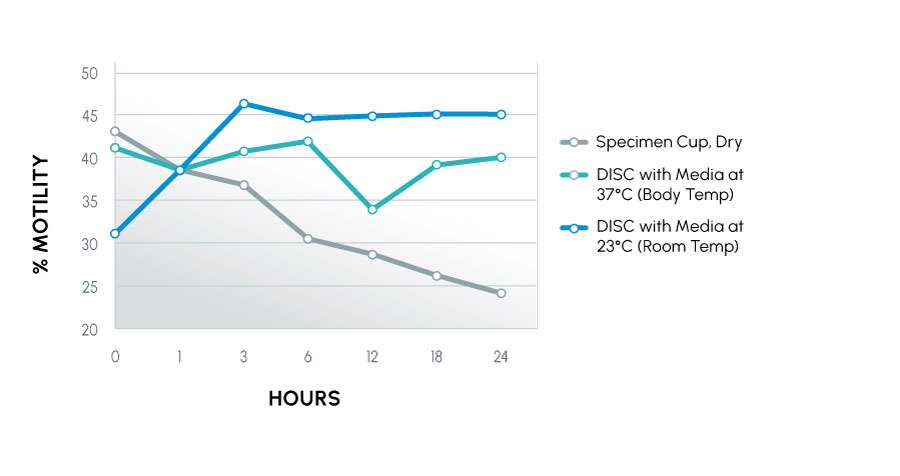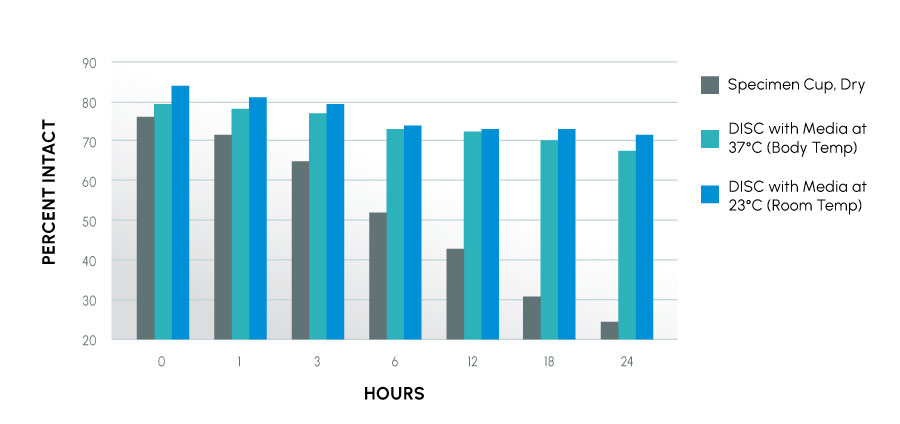Improving Semen Quality Using a Modified Collection Technique
Authors
Samuel Prien1 2, Dustie Johnson1
- Department of Animal and Food Sciences, Texas Tech University, Lubbock, TX
- Department of Obstetrics and Gynecology, Texas Tech University Health Sciences Center, Amarillo, TX
Publications
Fertility and Sterility Vol. 78, Supplement S226-S227. Published in issue: September 2002 – poster presentation.
Objective
The common practice of semen collection /extension techniques in humans, whether being used for intrauterine insemination, cryopreservation, or an advanced reproductive technique, is to collect the sample into a dry, unprotected specimen cup. Empirically, the environment provided by this container would allow drastic shifts in specimen temperature and pH resulting in spermatozoa damage. Previous studies in the canine have demonstrated long-term (days) improvement in semen parameters when the semen is collected into a modified collection device that provides a warm environment that is both pH and osmotically balanced. The objective of the present study was to determine if the same modification could be used to improve semen parameters in the human.
Design
Comparison of three semen collection techniques using a Latin Square to account for the variations between collections within the same donor.
Materials and Methods
Eight donors provided three semen samples each for the study. The study design was randomized by first collection. Control samples were collected into a standard, dry specimen cup. No attempt was made to hold the sample at body temperature prior to processing. The remaining two samples were collected into a modified container (DISC) that funneled the sample into a reduced volume central well, which contained 1 mL of a pH-buffered media and which was insulated from temperature fluctuations. In one case, the media was at 37°C, in the other the media was held at room temperature (23°C). Once collected, the samples were held for 15 minutes at 37°C prior to processing using a standard semen washing technique.
The samples were then placed in 5 mL of fresh media and incubated at 37°C with 95% relative humidity and 5% CO2. Standard semen parameters and biochemical markers were evaluated at times 0, 1, 3, 6, 12, 18 & 24 hours post-processing. Data analysis was performed with SPSS using the general linear model and appropriate t-tests.
Results
Both treatment groups maintained greater motility (p < 0.001), viability (p < 0.001), linearity (p < 0.001), and velocity (p < 0.001) with a significant increase of intact acrosomes over time as compared to the control over the 24-hour period. Motility in the two treatment groups was 6-fold higher than the control at 24 hours. The two treatment groups had 45% more intact acrosomes at 24 hours.
Conclusions
Modification of the semen collection / extension procedure resulted in improved semen parameters for extended time periods post-collection. The data suggests the described technique can yield significantly more motile sperm by placing the sample into a physiologically favorable environment, thus making those sperm available for use in a variety of infertility treatments.
Figure 1
Motility Over Time Using HAM’s F-10 Plus Serum

Insights
In this study, serum was added to the media to measure the impacts of media content to semen samples. We discovered the best performing combination was Ham’s F-10 plus serum. Today, most commercial media developed specifically for sperm washing already contains ~10% serum. In later studies, our researchers utilize third-generation media that includes pH-buffering agents and controls metabolite production.
Today, researchers are discovering the crucial role of media for at-home collection. The design of the DISC well allows for an optimal volume of media (1 mL) without the sample pooling to one side. Adding media prior to collection in a specimen cup requires ~5 mL of media to properly cover the sample, due to the larger area of the specimen cup’s bottom surface. That volume of media causes osmotic stress, damaging the sample before and after processing.
Figure 2
Percentage of Intact Acrosomes Over Time

Both treatments include Ham’s F-10 plus serum..
Insights
This study is the first to include a deeper review of acrosome membrane data, the leading indicator of biochemical health of the sperm and the potential for fertilization. Both DISC treatments follow a similar trendline that indicates the DISC itself vastly improves the percentage of intact acrosomes at all time points, regardless of media temperature. Samples within DISC at 23°C have 72% intact acrosomes at 24 hours, which is over 45% more intact acrosomes than a specimen cup. As with FIGURE 1 in this study, room temperature media outperforms media warmed to body temperature.
There is a severe downward trendline for the dry specimen cup, confirming the necessity to process specimen cup samples within an hour before further cellular and membrane damage occurs. Even so, at the initial reading, the specimen cup sample has 3% and 8% fewer intact acrosomes than DISC with media at 37°C and DISC with media at 23°C respectively. Intact acrosomes decreased 24% at 6 hours, and over 50% at 24 hours within the specimen cup sample. Biochemical marker research continues in STUDY 6 (pp. 20-22), comparing human samples collected in specimen cup, DISC dry, and DISC with media.
Direct insights into the research, methodology, and results have been added to this summary by the co-inventors themselves. This additional information is intended to provide helpful context to professional practitioners and does not fundamentally change the outcomes or interpretation of the published results. All ProteX research content and material is the property of Reproductive Solutions and may not be redistributed or republished without our consent. All rights reserved.
All Scientific Studies
Sample. Test. See for yourself.
Compare ProteX to the standard specimen cup with our sterile sample kit.